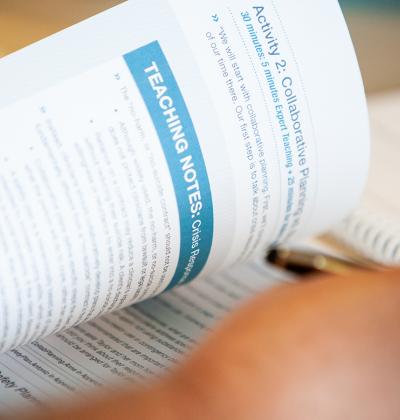
Assessing and Managing Suicide Risk for Direct Care Staff Working in Inpatient Behavioral Healthcare Settings
Over 48,000 people died by suicide in the U.S. each year. Inpatient mental health professionals play a critical role in the identification, assessment, and long-term management of suicide risk among their patients.
The AMSR for Direct Care Staff Working in Inpatient Settings curriculum develops skills in the recognition, assessment, and management of suicide risk and the delivery of effective suicide-specific interventions.
"AMSR for inpatient care has allowed clinicians to become more confident and competent in providing suicide safer interventions for individuals at the peak of a crisis.”
Assessing and Managing Suicide Risk
Assessing and Managing Suicide Risk (AMSR) teaches best practices recommended by the nation's leading experts in the research and delivery of suicide care.
We AMSR training based on the AMSR-Direct Care Inpatient curriculum for inpatient direct care staff including mental health and patient care technicians, LPNs, teachers, recreation and expressive therapists, case managers, recovery coaches, life skills, peer, and employment specialists, and others. Training in how to deliver AMSR-Direct Care Inpatient training is included in the AMSR-Inpatient Training of Trainers.
ASMR-Direct Care Inpatient Training is a half-day facilitated workshop offered in-person or online for non-clinical professionals seeking to improve their suicide care practice.
AMSR-Direct Care Inpatient Course is an on-demand course that offers three hours of instruction over three months of access for non-clinical professionals requiring a more flexible learning schedule.
Suicide and People Receiving Mental Health Care
Suicidal behavior is a major cause of death and disability in the United States. Each year, over 45,000 people die by suicide [1] and hundreds of thousands are seen in hospital emergency departments for suicide attempts [2]. A significant proportion of people who died by suicide had recent contact with a mental health professional. [3] However, many providers—psychologists, social workers, and other mental health counselors—are inadequately trained to assess, treat, and manage suicide risk in their clients. [4]
Assessing and Managing Suicide Risk (AMSR) fills that training gap by teaching the core competencies that meet suicide care standards established by national organizations including The Joint Commission, the National Action Alliance for Suicide Prevention, the Substance Abuse and Mental Health Services Administration, the Veterans Administration, and others.
Inpatient direct care professionals can help identify and support clients with suicide risk by using the suicide risk identification, assessment, and management competencies taught in the AMSR-Direct Care Inpatient training.
AMSR-Direct Care Inpatient Training
AMSR-Direct Inpatient training provides participants with the knowledge and skills they need to address suicide risk and behaviors in inpatient setting clients. Participants will have the opportunity to increase their knowledge and apply practical skills in the five areas of AMSR competency.
AMSR-Inpatient training follows national guidelines for caring for people with suicide risk.
- Guidelines
-
- National Action Alliance for Suicide Prevention Recommended Standard Care for People with Suicide Risk: Making Healthcare Suicide Safe
- VA/DoD Clinical Practice Guidelines Assessment and Management of Patients at Risk for Suicide
- The Joint Commission recommendations for compliance with NPSG 15.01.01 and Suicide Risk Recommendations from the Suicide Risk Reduction Expert Panel Suicide Prevention Portal
- National Action Alliance for Suicide Prevention Suicide Prevention and the Clinical Workforce: Guidelines for Training
- Citations
-
[1] Centers for Disease Control and Prevention (CDC). (2019). 2017, United States Suicide Injury Deaths and Rates per 100,000. WISQARS. National Center for Injury Prevention and Control, NCHS Vital Statistics System for numbers of deaths. Bureau of Census for population estimates. https://www.cdc.gov/injury/wisqars/fatal.html
[2] Rui P, Kang K, Ashman JJ. (2016). National Hospital Ambulatory Medical Care Survey: 2016 emergency department summary tables. Table 16. Emergency department visits related to injury, poisoning, and adverse effect, by intent: United States, 2016. https://www.cdc.gov/nchs/data/ahcd/nhamcs_emergency/2016_ed_web_tables.pdf https://www.cdc.gov/nchs/data/nhamcs/web_tables/2016_ed_web_tables.pdf
[3] Knesper, D. J., American Association of Suicidology, & Suicide Prevention Resource Center. (2010) Continuity of care for suicide prevention and research: Suicide attempts and suicide deaths subsequent to discharge from the emergency department or psychiatry inpatient unit. Newton, MA: Education Development Center, Inc.
[4] Ahmedani, B. K., Simon, G. E., Stewart, C., Beck, A., Waitzfelder, B. E., Rossom, R., … Solberg, L. I. (2014). Health care contacts in the year before suicide death. Journal of general internal medicine, 29(6), 870–877. doi:10.1007/s11606-014-2767-3
[5] Schmitz, W. M., Jr, Allen, M. H., Feldman, B. N., Gutin, N. J., Jahn, D. R., Kleespies, P. M., . . . Simpson, S. (2012). Preventing suicide through improved training in suicide risk assessment and care: An American Association of Suicidology Task Force report addressing serious gaps in U.S. mental health training. Suicide and Life Threatening Behavior, 42(3), 292–304.
[6] National Action Alliance for Suicide Prevention: Transforming Health Systems Initiative Work Group. (2018). Recommended standard care for people with suicide risk: Making health care suicide safe. Washington, DC: Education Development Center, Inc.
[7] Knesper, D. J., American Association of Suicidology, & Suicide Prevention Resource Center. (2010) Continuity of care for suicide prevention and research: Suicide attempts and suicide deaths subsequent to discharge from the emergency department or psychiatry inpatient unit. Newton, MA: Education Development Center, Inc.
AMSR-Inpatient
This training is best taken by those working in organizations where clinicians are trained in the full 6.5-hour version of AMSR for Inpatient Settings so that treatment teams of clinicians and direct care staff can speak the same risk assessment and management language to provide consistent, effective care.